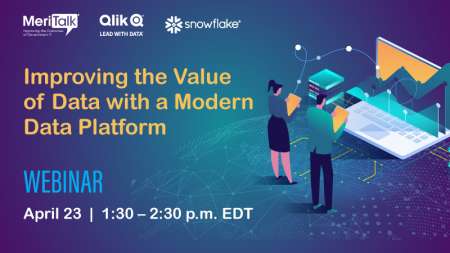
Steven Nguyen, Vice President and General Manager-Public Sector at Citrix, has charted a career path that could serve as a virtual roadmap for informing and supporting the Federal IT industry enterprise over the past three decades. Beginning with an analyst position at the State Department, and then moving up the ranks with the likes of Oracle, Metaserver, Digital Harbor, and LexisNexis, Nguyen now sits squarely on the front lines of supporting the government in a time of crisis.
We sat down with Nguyen earlier this month to get his take on the government’s quick turn to telework, what the Feds need to consider over the next few months as the pandemic abates, and what agency CIOs may want to think about a year from now as they ponder modernization strategies that can outlast whatever surprises the future may hold. Here’s what he had to say:
MeriTalk: What can the Federal government do right now on the tech front to better sustain or improve service to citizens, and to the government workforce?
Nguyen: It’s pretty easy from a tech standpoint – the government needs to give its employees easy, secure, and reliable access to the tools and capabilities in their homes that up until recently they had in their offices so they can stay as efficient as possible. This includes everything from an applications standpoint to the “soft” solutions, such as the impromptu face-to-face meetings. That takes a lot, and it covers a lot of different facets. The first is providing users with exactly the tools they had, so that the workflow is the same, and everything works exactly as if they were in the office. The second is that the tools offer a level of efficiency to yield a good user experience – they must have the ability to get files they need or get to an application without waiting for five minutes. It’s got to work – quick and fast – just like it does when they are in the office.

MeriTalk: In talking to Federal agencies and private sector providers over the past few weeks, we get the sense that the move to telework is going pretty well for the most part. What is your take?
Nguyen: I think so too. And there’s different ways of attacking the problem that can allow employees and customers to access information via VPN, and they can use solutions like Citrix that provide secure solutions like remote PC, virtualization, and solutions that can be deployed to the cloud, in a hybrid multi-cloud and on-premise architecture. There’s many different solutions out there that give the Federal government the ability to choose what route they want to take depending on where they are with their work from anywhere stance before the COVID-19 pandemic. That’s the big challenge, determining what their preparation was for this and then taking it from there.
Some customers might have had VPN on a small scale, and now want to use that on a large scale. Some that were using Citrix Workspace or sector-specific virtual apps and desktops, with 10,000 users a day, may need to boost that number. The mechanism for them to do that is really easy, what they have to figure out is the capacity and there are a few variables to consider: if it was an on-premise solution, how do they add more services and increase network capacity to handle the new load for example. In addition, many VPN solutions were designed to support a small fraction of the employee base, not the entire employee base. In some instances, we are hearing customers move away from their VPN solution to a Citrix Workspace solution due to user experience, constant outages, and security vulnerabilities.
MeriTalk: Let’s say the time to a pandemic recovery is six months, what can Federal agency leadership do over that period to get ready for the recovery?
Nguyen: You are going to see policy changes in the commercial sector as well as the government in the next six months. Companies and agencies are going to learn a lot in this crash course on what “can be” going forward for a workforce that has proven to be effective in a telework setting. There a couple of things the government should be looking at during the next six months:
- Now is the time to look at the solution that was quickly put in place to make sure it provides the right amount of security, usability, and tools that make for a ‘work from anywhere’ workforce. If you expanded your VPN solution, now may be the time to step back to see if that is providing the right level of security, performance, and usability. If it isn’t, maybe a good look into a more enterprise desktop virtualization solution that is easily scalable and secure and provides the user experience needed, is required.
- Build up and secure the network infrastructure. More than likely the network infrastructure was not designed to deal with the huge spike in teleworkers.
- Put a taskforce together that looks at the “workflow” of the new telework environment and see if there are applications and processes that can be redesigned to provide for better efficiencies.
Beyond six months, it’s important to see what works and how do we take advantage of this new model – and make it part of the new normal – of allowing people to work from anywhere.
There are many agencies that were ready and just needed to scale, and some that just put together a quick solution to deal with the pandemic.

What the government should be doing now is looking at assets and stepping back and saying what is the enterprise platform that we want to implement going forward. What we’ve done in the past few weeks is to set up new services very quickly, and when doing that, sometimes not taking the best long-term approach. We’ve been taking the fastest approach, but not necessarily the best approach.
For example, VPN is a great solution, but there are a lot of security concerns around VPN, as well as network concerns, and with throughput. Maybe that’s a long-term solution. Or maybe a solution that uses virtual applications, virtual desktop, and a database virtualization solution can be something to look at as an enterprise platform.
One of the biggest pushes in the Federal government, is the move to the cloud. So maybe take the time now to figure out what is the right architecture in the cloud, especially with all the data center consolidation that is going on in the government. Maybe now is the time to say we can move on, perhaps adopt a hybrid approach where you can leave some things that are currently on-prem in data centers, and then leave the rest in the cloud. That could be the right solution that gives the ability to scale so if in the future something big like the pandemic happens again, we can scale very easily, and it’s a well thought-out solution that takes security into account.
Some other things to consider could be:
- Revisit telework or catastrophic planning policies to make sure that if an event like this happens again, we are ready for it. I know some agencies are already talking about a regular ‘telework at home’ test to happen every few times a year to make sure all the systems, tools, and personal are prepared.
- Revisit burst licensing for all agency contracts to make sure that there is something in place. One of the major efforts in the past few weeks was working government procurement shops 24/7.
MeriTalk: What are some of the security concerns?
Nguyen: Right now we are sending people home with laptops or to use computers at home to access the agency network. They are doing a lot of things on conference calls, and emailing files back and forth that should be secure, so there a lot of holes from a security standpoint. One of the advantages of looking out six months is to determine how we take step back, plug all the holes, and create a good security solution. One of the things we are hearing everyday now is there are a lot more scammers out there, a lot more phishing, a lot more VPN intrusions. And we have hundreds of thousands of people working at home sharing important security documentation, some of them in the clear, some of them not even encrypted.
MeriTalk: Is this period really amounting to a crash course in modernization?
Nguyen: Partially. We’ve been talking about modernization with our customers over the last few years where we’ve been collaborating on the workspace of the future. And in some ways that quick course in modernization has been happening over the past few weeks, where we say we don’t have to time to figure all that stuff out, you’ve just got to move now. I’ve seen some customers that have a few thousand people telework employees and now just had to deploy to over 30,000 people over the weekend. The key now is to take what we’ve done in this crash course and use those assets to really provide a new modernized digital workspace for all its workers to be able to work anywhere; in the office or at home.
MeriTalk: What can your company do today, and over the next six months, to help the Federal government prepare for what’s to come after that?
Nguyen: We have a lot of solutions that allow customers to get up and running very quickly. For example, we used our remote PC solution to get a brand-new customer up and running with almost 30,000 users over a weekend. That’s really huge, and then for all the existing customers of ours that are heavily invested in the Citrix Workspace, or the Citrix Virtual Apps and Desktops, very quickly and very easily scale to hundreds of thousands of users, whether that be an on-premise solution or cloud solution. The infrastructure allowed them to scale up to the numbers they needed very quickly. And the customers didn’t have to go out and buy 20,000 laptops to make it happen.
MeriTalk: Six to 12 months from now when you are sitting in a CIO’s office, what’s the conversation going to be like then?
Nguyen: COVID-19 will have long lasting effects. One of the most expensive costs for any government or commercial agency is real estate. Another soft cost for many, especially around the D.C. area, is the time employees spend in the car coming and going to work; something many of us have experienced. Lastly, many employees have always had concerns about the effectiveness of their workforce at home, but what people are seeing is that people are effective, and in many cases, they are seeing their workforce work longer hours. For these reasons alone, I believe the federal agency will rethink the way work gets done and what the new norm can be.
Six months from now, I believe the conversation with the CIO will be about what the customer really needs to do from a mission and workflow standpoint to truly create a new modernized workspace, and that’s what the Citrix Workspace is all about – organizing, guiding and automating work for every employee so that they can perform at their best.
One of the biggest efforts will be around better understanding the customer’s workflow to develop micro-apps that will use AI and machine learning to provide an intelligent workspace that creates a new and better experience for the user.
Among the biggest questions will be how do you do this from an architectural standpoint, how do you want to scale in the cloud, and how do you want to make sure that the right security is there so that nothing gets lost to the bad guys.
Then we can look at what needs to be virtualized and customized to make a better solution for the end users, and make that cleaner and more efficient that it is today. And how do we architect a solution that can scale and really burst when needed, so that in the future when something like this happens again, you can easily send everyone home and burst really quickly to what you need, until you can go back to the office again.
